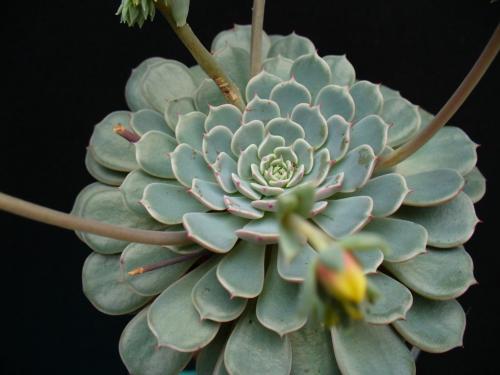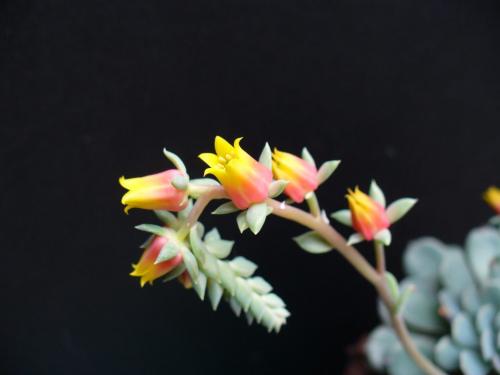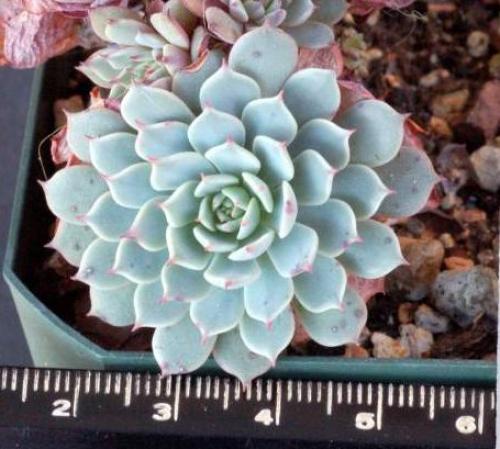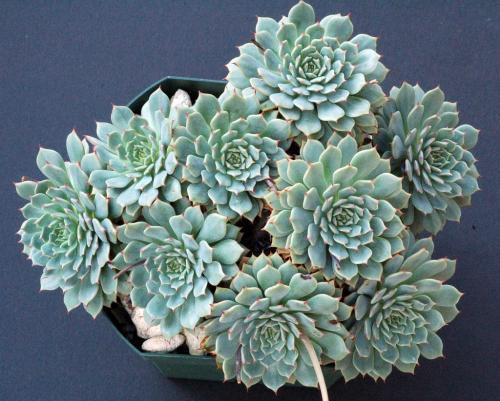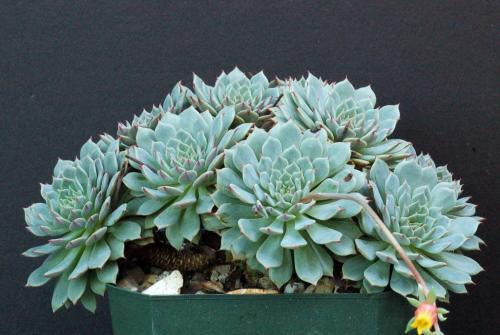PINWHEEL (provisional name) (engl./ fr.)
Originally distributed by ISI n° 1470, 1984 as E. secunda 'Pinwheel'.
However this plant is not a cultivar of E. secunda but a not yet described species from Tuxpan, Michoacán, Mexico. It closely resembles E. secunda but its locality (according to Charles Uhl) is "well south and west of the range of typical E. secunda ....[and] the cytological differences clearly show that [it is a] different biological species from typical E. secunda" (Haseltonia 6, 1998).
Echeveria Pinwheel has never been formally described nor has a type specimen been prepared. However there exists a detailed
Description by Reid Moran made from a plant collected by Felipe Otero on rocks and high cliffs near Tuxpan, Michoacán, August 1972 (Otero 004) :
Caudex short, to 1.5 cm thick.
Rosettes sessile, first solitary, becoming caespitose, up to 6.5 cm wide of ca 50 - 60 leaves, flattish.
Leaves blue-glaucous, a little marked with purplish red near the apex, cuneate-spatulate, subtruncate, mucronate, 2 - 3.5 cm long, ca 14 -17 mm wide above and 2 - 4 mm at base, 3.5 - 5 mm thick above, convex dorsally, flattish ventrally, the margins subacute, the mucro ca 2 mm long, red.
Floral stems 4.5 - 8 cm to inflorescence, 2 - 3 mm thick at base, purplish, glaucous, bare in lower part, with 4 - 8 ascending leaves below inflorescence, these obovate, obtuse, apiculate, to 15 x 8 x 3 - 4 mm.
Cincinnus of 14 - 16 flowers, pedicels 1 - 3 mm long, 1 - 1.5 mm thick, calyx disk 3 mm wide, the segments ascending-spreading, markedly unequal, the smallest 1.5 - 2 x 1 - 1.5 mm, the largest 5 - 8 x 2.5 - 4 mm, corolla 9 - 10 mm long, 6.5 - 7 mm wide at base, 6 mm wide at the slightly outcurved tips, watermelon pink in lower half, yellow above, pentagonal with sides nearly flat, petals connate ca 1.5 mm, oblong, acute, apiculate, 3 mm wide, the nectar pit rounded, ca 2 mm long and wide, filaments yellowish, ca 6 mm long from corolla base, the epipetalous adnate ca 2 mm, the antesepalous ca 1 mm, nectar glands whitish, ca 1.5 mm wide, with secretory face outward, gynoecium 7 mm high, 4 mm thick, whitish, narrowing abruptly to greenish styles ca 1 mm long.
Cytology : n = 13
It is very obviously not the same plant as described by E. Walther as E. elegans var. tuxpanensis (and of course also not E. secunda var. tuxpanensis as erroneously stated in Pilbeam, The genus Echeveria, p. 322, 2008).
E. Pinwheel is somewhat variable, there is a more greenish as well as a more bluish-pinkish form. The locality for both forms is the same : Tuxpan in the Mexican state Michoacán. Therefore also the name for both forms is the same : E. Pinwheel. There cannot be two different names for two forms only differing in leaf colour but otherwise identical.
------------------------------------------------------------------------------------------------------
The English text above and the French text below have been updated recently so please check the English or the French version for the correct information !
에케베리아 핀휠은 다소 다양성을 띄고 있어, 푸르스름한 분홍색 폼 뿐만 아니라 녹색 폼도 존재한다. 두 폼의 자생지는 멕시코 미쵸아깐주의 툭스판 지역이다. 따라서, 두 폼의 이름은 에케베리아 핀휠로 동일하다. 잎색만 다르고 나머지 특성이 동일한 두 폼에 대하여 다른 이름을 붙일 수는 없다.
----------------------------------------------------------------------------------------------------
Distribué à l'origine en tant que ISI n° 1470, en 1984, sous le nom E. secunda 'Pinwheel'.
Cependant, cette plante n'est pas un cultivar d'E. secunda mais une espèce non encore décrite, originaire de Tuxpan, Michoacán, Mexique. Elle ressemble vraiment à E. secunda mais sa localisation (selon Charles Uhl) est " bien au sud et à l'ouest de l'aire de répartition d'E. secunda [...] les différences cytologiques montrent clairement qu'il s'agit d'une espèce biologiquement différente de l'espèce type E. secunda " (Haseltonia 6, 1998).
Cytologie : n = 13
Il ne s'agît pas du tout de la même plante que celle décrite par E. Walther sous le nom E. elegans var. tuxpanensis - et non pas d' E. secunda var. tuxpanensis, comme l'a erronément mentionné Pilbeam (The genus Echeveria, p. 322, 2008).
Plants in habitat :
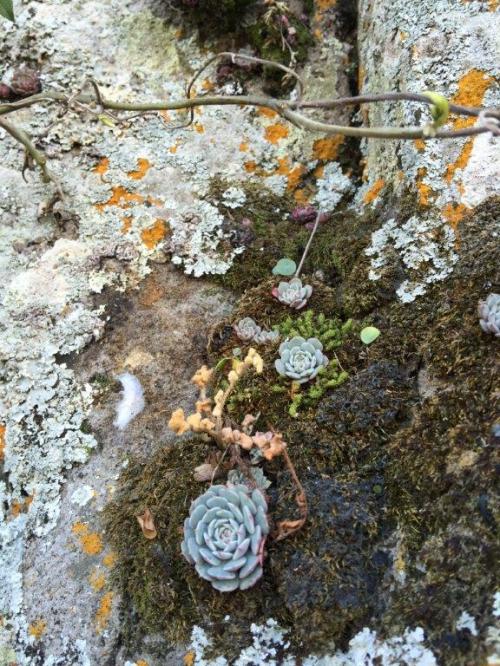
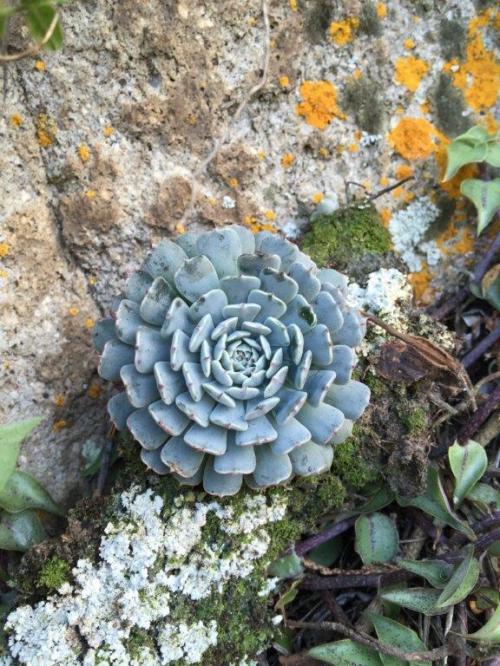
Photos Gerhard Köhres
Plants in cultivation :
